- The paper shows that JWST/NIRSpec transmission spectra, analyzed via Gaussian Process techniques, effectively mitigate stellar contamination.
- It establishes robust lower limits on mean molecular weight (μ > 8.6 ± 0.4 u) that rule out H2-dominated atmospheres in favor of a high–μ, N2-rich scenario.
- The retrievals hint at tentative CH4 absorption and weak CO2 constraints, suggesting potential habitability while underscoring the need for further observations.
Constraints on the Secondary Atmosphere of TRAPPIST-1e from JWST-TST DREAMS
Introduction
The TRAPPIST-1 system, with its seven Earth-sized planets orbiting an ultracool M dwarf, provides a unique laboratory for comparative exoplanetology and the search for habitable environments beyond the Solar System. TRAPPIST-1e, located in the system's habitable zone, is a prime target for atmospheric characterization due to its favorable size, mass, and irradiation. This paper presents a comprehensive analysis of four JWST/NIRSpec PRISM transmission spectra of TRAPPIST-1e, focusing on the constraints these data place on the presence and nature of a secondary atmosphere. The analysis employs a hierarchy of modeling approaches, from simple flat-line fits to sophisticated joint stellar contamination–atmosphere retrievals, to robustly interpret the data in the presence of significant stellar activity.
Observational Data and Stellar Contamination
The four JWST/NIRSpec PRISM transits of TRAPPIST-1e exhibit substantial visit-to-visit variability, attributed to time-varying stellar surface inhomogeneities such as spots and faculae. Visits 1 and 2 are relatively quiescent, while Visits 3 and 4 are heavily contaminated, including a mid-transit flare in Visit 3. Traditional stellar models fail to adequately correct for this contamination. Instead, a Gaussian Process (GP) framework is employed to model and mitigate broad, time-varying stellar trends, though this approach does not capture all physical complexities of the stellar surface.
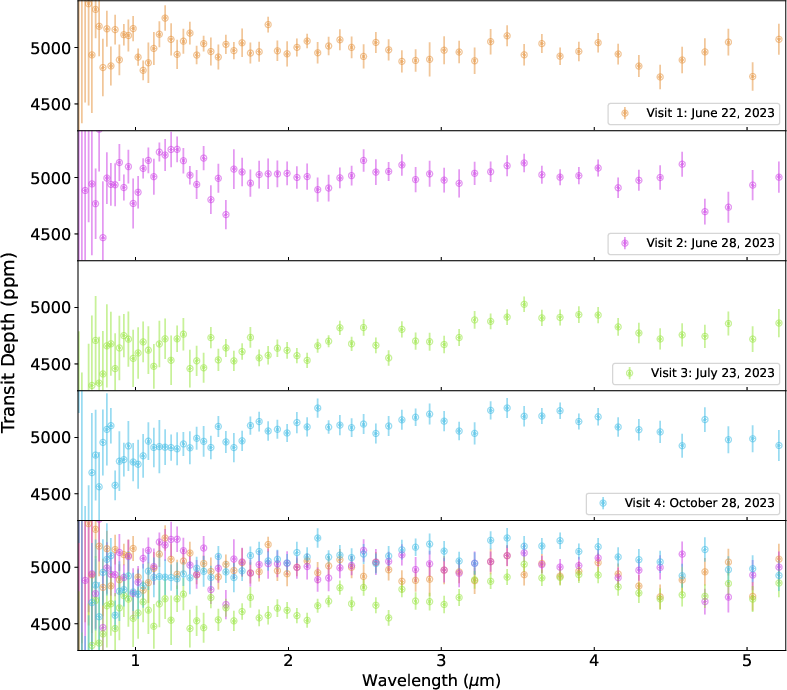
Figure 1: JWST NIRSpec PRISM transmission spectra from each of the four visits (uncorrected), showing significant transit-to-transit differences due to stellar contamination.
The data reduction strategy prioritizes the less contaminated Visits 1 and 2 for initial atmospheric inference, with subsequent analyses incorporating the GP-corrected combination of all four visits.
Forward Modeling and Model-Agnostic Constraints
Flat-Line and Mean Molecular Weight Limits
A flat-line model, representing either a bare rock or a high-altitude cloud deck, provides an adequate fit to the transmission spectra for Visits 1 and 2 and the GP-corrected combined spectrum. The lack of detectable molecular features enables a model-agnostic lower limit on the mean molecular weight (μ) of any putative atmosphere. For the combined Visits 1 and 2, μ>3.9±0.8 u is derived, improving to μ>8.6±0.4 u for the GP-corrected four-visit spectrum at wavelengths >1μm. These values effectively rule out H2-dominated atmospheres and are consistent with high-μ (e.g., N2- or CO2-dominated) scenarios.
Grid-Based Forward Model Comparisons
A grid of forward models, generated with petitRADTRANS, explores a range of atmospheric compositions (N2, H2, CO2, CH4) and surface pressures. The data robustly exclude H2-rich atmospheres with even trace amounts of strong absorbers (CO2, CH4), as these would produce spectral features well above the detection threshold. In contrast, N2-rich atmospheres with trace CO2 and CH4 remain consistent with the observations. High-pressure CO2 atmospheres analogous to Venus or Mars are weakly disfavored at the 2σ level.
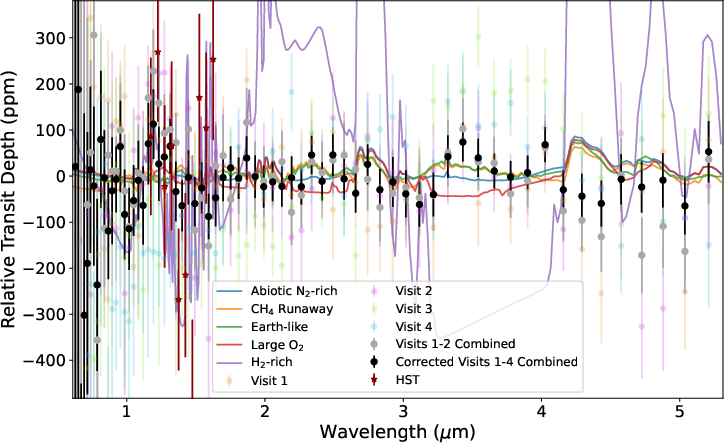
Figure 2: JWST NIRSpec PRISM transmission spectra compared with a suite of modeled atmospheric scenarios, illustrating the exclusion of H2-rich atmospheres and the consistency of high-μ scenarios with the data.
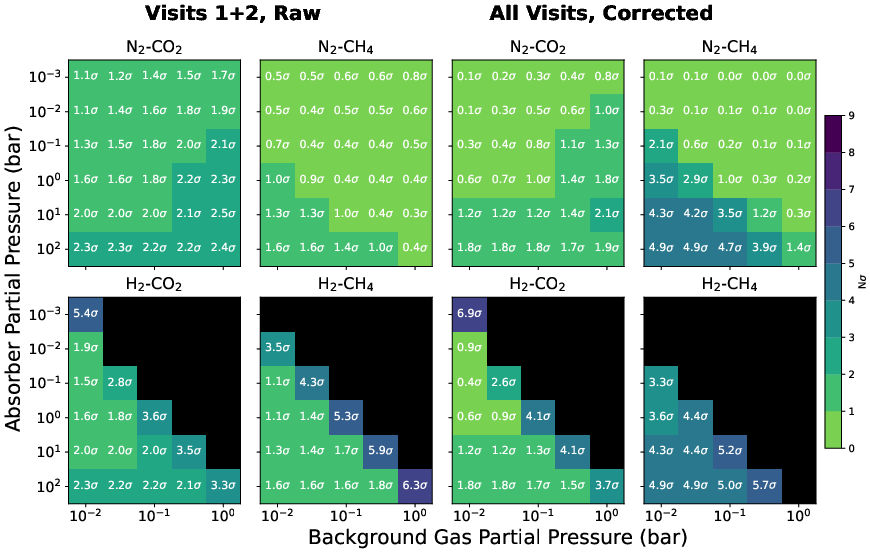
Figure 3: Rejection significance for atmospheric forward models as a function of background and absorber partial pressures, highlighting the exclusion of large regions of H2-rich parameter space.
Retrieval Analysis: Joint Stellar and Atmospheric Inference
A Bayesian retrieval framework, implemented with POSEIDON and a GP model for stellar contamination, is used to jointly constrain atmospheric properties and residual stellar effects. Two retrieval configurations are considered: (1) a centered log-ratio (CLR) prior allowing any gas to dominate, and (2) a "ghost" background gas with a freely fit mean molecular weight and log-uniform priors on spectrally active species.
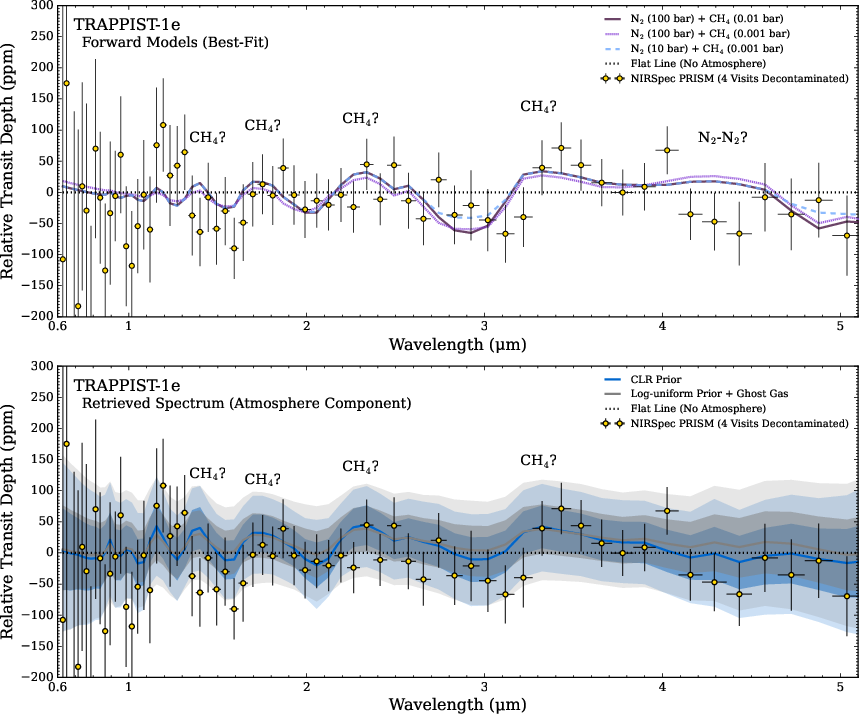
Figure 4: Spectral fits to the GP-corrected transmission spectrum, showing best-fit forward models and retrievals for different atmospheric scenarios. Both approaches identify features tentatively consistent with CH4 absorption.
The retrievals do not yield statistically significant detections of any molecule. However, both the CLR and ghost gas frameworks identify a tentative preference for CH4 absorption in a spectrally inactive (e.g., N2) background, though the evidence is insufficient for a robust detection. The posteriors for CO2 and CH4 abundances and surface pressures are broad, with only weak upper limits on CO2 that disfavor Venus- and Mars-like atmospheres at 2σ.
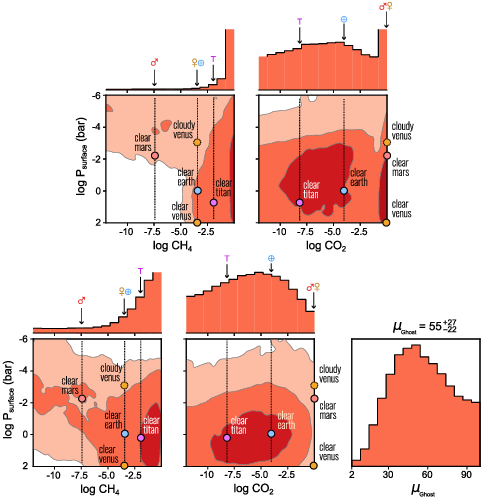
Figure 5: Posterior distributions for CH4 and CO2 volume mixing ratios versus effective surface pressure, compared to Solar System analogs. The retrievals allow a wide range of scenarios, with only weak exclusion of high-pressure CO2 atmospheres.
The ghost gas retrieval yields a posterior for the mean molecular weight peaking at 55−22+27 u, consistent with a heavy, spectrally inactive background gas.
Implications for Habitability and Atmospheric Evolution
The absence of strong CO2 features and the exclusion of H2-rich atmospheres have direct implications for the potential habitability of TRAPPIST-1e. Climate models indicate that surface liquid water requires pCO2>0.002−0.1 bar, depending on background gas and albedo assumptions. The retrievals weakly disfavor pCO2≳0.7 bar at >2σ, but lower values remain permitted, leaving open the possibility of a habitable surface.

Figure 6: Posteriors in temperature space for pCH4 and pCO2, showing that high pCO2 is weakly disfavored, but a wide range of cold scenarios remain allowed.
The tentative preference for CH4 absorption, if confirmed by future data, would suggest a Titan-like N2-CH4 atmosphere, though the photochemical and climatic stability of such an atmosphere under TRAPPIST-1e's irradiation is uncertain. The lack of a strong scattering slope argues against a thick photochemical haze, but this remains to be tested with higher SNR data.
Limitations and Future Prospects
The dominant limitation in the current analysis is the pervasive stellar contamination, which is only partially mitigated by the GP approach. The GP cannot distinguish between time-invariant stellar features and planetary atmospheric signals, leading to potential degeneracies. The statistical preference for a flat-line model over atmospheric scenarios underscores the need for additional data.
Ongoing JWST programs will obtain 15 additional transits of TRAPPIST-1e, including consecutive observations of TRAPPIST-1b and e. This strategy will enable differential correction for stellar contamination by leveraging the likely airless nature of TRAPPIST-1b as a stellar reference. These data will provide a decisive test of the tentative atmospheric hints reported here and enable robust constraints on the presence and composition of a secondary atmosphere.
Conclusion
The JWST-TST DREAMS program provides the first multi-transit transmission spectra of TRAPPIST-1e, enabling the most stringent constraints to date on its secondary atmosphere. The data robustly exclude H2-rich atmospheres and weakly disfavor high-pressure CO2 scenarios, but remain consistent with both a bare rock and a high-μ, N2-rich atmosphere with trace CH4. No statistically significant molecular detections are made, and the dominant source of uncertainty remains stellar contamination. The forthcoming expanded JWST dataset will be critical for resolving these ambiguities and advancing the characterization of temperate terrestrial exoplanets.





